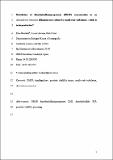Por favor, use este identificador para citar o enlazar a este item:
http://hdl.handle.net/10261/46038COMPARTIR / EXPORTAR:
 SHARE SHARE
 CORE
BASE CORE
BASE
|
|
| Visualizar otros formatos: MARC | Dublin Core | RDF | ORE | MODS | METS | DIDL | DATACITE | |

| Título: | Modulation of dimethylsulfoniopropionate (DMSP) concentration in an Alexandrium minutum (Dinophyceae) culture by small-scale turbulence: A link to toxin production? |
Autor: | Berdalet, Elisa CSIC ORCID ; Llaveria, Gisela CSIC; Simó, Rafel CSIC ORCID | Palabras clave: | Alexandrium minutum Dinoflagellates DMSP Paralytic shellfish toxins Small-scale turbulence |
Fecha de publicación: | nov-2011 | Editor: | Elsevier | Citación: | Harmful Algae 11: 88-95 (2011) | Resumen: | Some marine dinoflagellates produce important amounts of dimethylsulfoniopropionate (DMSP), a common compatible solute, and its cleavage product dimethylsulfide (DMS), a climatically active trace gas. In the field, dinoflagellate proliferations appear to be favored by calm weather and water column stability; indeed, small-scale turbulence is a physical factor that directly affects ecophysiological aspects of this phytoplankton group, including toxin production. Here we report the effect of experimentally generated turbulence on DMSP production by a paralytic shellfish poisoning (PSP) toxin producing strain of Alexandrium minutum, a widespread bloomforming dinoflagellate species. With respect to still conditions, the populations exposed to turbulence grew at a slower growth rate and yielded low cell numbers turbulence. Concurrently, the cellular DMSP concentration increased by ca. 20% (from 0.22 ± 0.01 to 0.27 ± 0.03 fmol μm−3 on a cell volume basis) in the shaken cultures. DMSP was preferentially synthesized during the light period in both treatments. During the night, a slowdown of the division process caused DMSP accumulation in the cells exposed to shaking. The study suggests the existence of a tight link between the dynamics of DMSP concentration and other cell processes entrained by circadian rhythms in dinoflagellates. The observed effects of small-scale turbulence on the DMSP dynamics supports the suggested role of this compound as an overflow mechanism in metabolically unbalanced cells. Furthermore, considering all the effects on the physiology of A. minutum exposed to the same experimental setup, we propose a possible link between the DMSP and the PSP metabolisms | Descripción: | 8 pages, 3 figures | Versión del editor: | https://doi.org/10.1016/j.hal.2011.08.003 | URI: | http://hdl.handle.net/10261/46038 | DOI: | 10.1016/j.hal.2011.08.003 | ISSN: | 1568-9883 |
| Aparece en las colecciones: | (ICM) Artículos |
Ficheros en este ítem:
| Fichero | Descripción | Tamaño | Formato | |
|---|---|---|---|---|
| Berdalet_et_al_2011_Postprint.pdf | 405,01 kB | Adobe PDF |  Visualizar/Abrir |
CORE Recommender
SCOPUSTM
Citations
11
checked on 20-abr-2024
WEB OF SCIENCETM
Citations
10
checked on 27-feb-2024
Page view(s)
361
checked on 23-abr-2024
Download(s)
404
checked on 23-abr-2024
Google ScholarTM
Check
Altmetric
Altmetric
NOTA: Los ítems de Digital.CSIC están protegidos por copyright, con todos los derechos reservados, a menos que se indique lo contrario.
